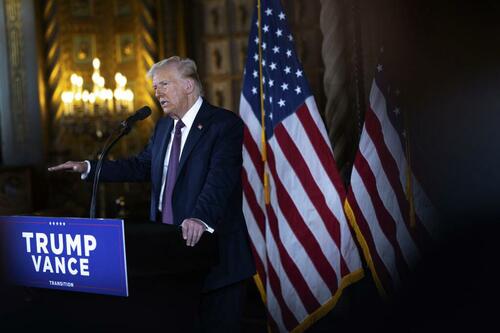Trump’s ‘Crazy’ Ideas Not So Crazy After All
Authored by Lawrence Kadish via The Gatestone Institute,
Why is it that people are always calling for someone to think “outside the box,” then when someone does, say, “Aaaak! He thought outside the box!”
In that view, President-elect Donald J. Trump has already committed (at least) three heresies: Buy Greenland, stop China from controlling the Panama Canal and deepen America’s affiliation with Canada.
All three ideas are neither crazy nor even new.
President Harry S. Truman looked at acquiring Greenland in 1946.
Thomas Jefferson, after the Louisiana Purchase, proposed buying Cuba – just think how the Cubans would be prospering now, politically and economically, if that deal had gone through. Those acquisitions didn’t take place but in 1917, the US did acquire Denmark’s Virgin Islands for $25 million. As historian Stephen Press writes,
“As secretary of state, John Quincy Adams arranged debt relief for Spain in exchange for Florida. Secretary of State William Seward acquired Alaska. What Mr. Trump proposes is consistent with this American tradition—and with our current borders. Sovereignty purchases are responsible for more than 40% of U.S. land…
“History suggests the benefits of being open-minded about this. Inhabitants of Alaska wouldn’t be better off under Russian sovereignty. Bringing Greenlanders into closer affiliation with the U.S., and sweetening the deal with economic subsidies, could conceivably prove beneficial to all parties”
As for the Panama Canal, President Jimmy Carter handed it to Panama for $1, but on the condition that it permanently remain a neutral zone – not one controlled at both ends by China.
“We gave the Panama Canal to Panama,” Trump has pointed out.
“We didn’t give it to China. They’ve abused that gift.”
The US built the Panama Canal in the first place to be able to avoid having commercial and military sea traffic avoid the long journey around South America’s southernmost sea route, the Strait of Magellan – where the Chinese Communist Party also located a base.
If there were to be a conflict with Communist China, it would be easy enough for them to block the Canal to U.S. use. As China expert Gordon G. Chang has pointed out:
“China’s port facilities are at both ends of the canal. And when Gen. Laura Richardson took a helicopter ride over the Canal Zone, this was the middle of 2022; she said she ‘looked down and saw all of these dual-use facilities.’ … at a time of war, they could make the canal totally useless…. They say that we have a two-ocean Navy. Well, we would have two separate navies. It’d be very difficult to get ships from the Atlantic to the Pacific, or vice versa.”
Closer ties with Canada, as Trump appears to see them, would make a united-in-some-way North America a formidable landmass to any would-be adversary.
“You get rid of that artificially drawn line,” Trump stated, “and you take a look at what that looks like, and it would also be much better for national security. Don’t forget, we protect Canada.”
Trump seems to have been merely responding to the opening provided him by Canadian Prime Minister Justin Trudeau, days before the latter announced that he would be resigning. According to Trump:
“I said what would happen if we didn’t do it. He said Canada would dissolve. Canada wouldn’t be able to function, if we didn’t take their 20% of our car market… So, I said to him, well, why are we doing it? He said, I don’t really know. He was unable to answer the question, but I can answer it. We’re doing it because of habit, and we’re doing it because we like our neighbors ,and we’ve been good neighbors. But we can’t do it forever and it’s a tremendous amount of money. And why should we have a $200 billion deficit and add on to that many, many other things that we give them in terms of subsidy?”
Trump has also announced a “Made in America,” tax break incentive for investment in the US, and a “Golden Age of America.”
It seems to have begun already — and he is not even president yet.
Tyler Durden
Sat, 01/11/2025 – 10:30


